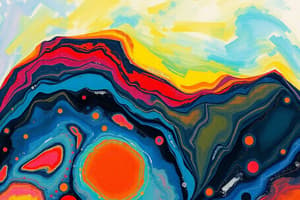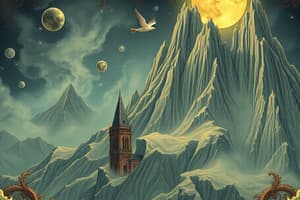Podcast
Questions and Answers
What is the primary characteristic of the asthenosphere that distinguishes it from the lithosphere?
What is the primary characteristic of the asthenosphere that distinguishes it from the lithosphere?
- It is composed entirely of solid rock.
- It represents the uppermost layer of the Earth's structure.
- It ranges from 0 to 100 km beneath the Earth's surface.
- It allows for ductile flow due to its semi-fluid state. (correct)
Which statement accurately describes the difference between continental and oceanic crust?
Which statement accurately describes the difference between continental and oceanic crust?
- Oceanic crust is older and made primarily of granitic rocks.
- Continental crust is denser and thinner than oceanic crust.
- Oceanic crust is more complex geologically than continental crust.
- Continental crust can range from 20-70 km in thickness while oceanic crust is usually 5-10 km thick. (correct)
What is the primary cause of earthquakes as outlined in the study notes?
What is the primary cause of earthquakes as outlined in the study notes?
- Tectonic plate movement along faults. (correct)
- Shifts in the Earth's magnetic field.
- Sudden temperature changes in the Earth's crust.
- Volcanic eruptions releasing pressure.
Which type of fault is associated with the compression of the Earth's crust?
Which type of fault is associated with the compression of the Earth's crust?
Which of the following is a characteristic of stratovolcanoes?
Which of the following is a characteristic of stratovolcanoes?
What is the focus of an earthquake?
What is the focus of an earthquake?
Which property of the lithosphere allows it to create earthquakes?
Which property of the lithosphere allows it to create earthquakes?
What primarily drives volcanic activity at tectonic plate boundaries?
What primarily drives volcanic activity at tectonic plate boundaries?
Which of the following accurately describes the composition of oceanic crust?
Which of the following accurately describes the composition of oceanic crust?
At what depths does the asthenosphere lie beneath the Earth's surface?
At what depths does the asthenosphere lie beneath the Earth's surface?
Flashcards are hidden until you start studying
Study Notes
Plate Tectonics Study Notes
Asthenosphere Properties
- Definition: The asthenosphere is a semi-fluid layer located beneath the lithosphere, part of the upper mantle.
- Physical State: Composed of partially molten rock (magma) that allows for ductile flow.
- Depth: Ranges from about 100 km to 700 km beneath the Earth’s surface.
- Role in Tectonics: Facilitates the movement of tectonic plates by providing a flexible layer that can deform under stress.
Lithosphere Characteristics
- Definition: The lithosphere is the rigid outer layer of the Earth, comprising the crust and uppermost mantle.
- Thickness: Varies from approximately 5 km (oceanic) to about 100 km (continental).
- Composition: Consists of solid rock, including igneous, metamorphic, and sedimentary types.
- Behavior: Rigid and brittle; it can break and create earthquakes.
Types of Crust
-
Continental Crust:
- Thicker (20-70 km) and less dense than oceanic crust.
- Composed mainly of granitic rocks.
- Older and more complex geologically.
-
Oceanic Crust:
- Thinner (5-10 km) and denser than continental crust.
- Composed primarily of basaltic rocks.
- Younger than continental crust, constantly being formed and destroyed at mid-ocean ridges and subduction zones.
Earthquake Mechanisms
- Definition: Earthquakes are the result of sudden releases of energy in the Earth's crust, creating seismic waves.
- Causes:
- Tectonic Plate Movement: Most earthquakes occur due to the movement of plates along faults.
- Types of Faults:
- Normal Faults: Occur due to tension; the crust is extended.
- Reverse (Thrust) Faults: Occur due to compression; one block is pushed over another.
- Strike-Slip Faults: Horizontal displacement; plates slide past each other.
- Focus and Epicenter:
- Focus: The point within the Earth where the earthquake originates.
- Epicenter: The point directly above the focus on the Earth's surface.
Volcanic Activity
- Definition: Volcanic activity refers to the eruption of molten rock, gases, and ash from a volcano.
- Causes:
- Occurs primarily at tectonic plate boundaries, especially divergent (mid-ocean ridges) and convergent (subduction zones) settings.
- Types of Volcanoes:
- Shield Volcanoes: Broad, gently sloping sides; formed by low-viscosity lava (e.g., Mauna Loa).
- Stratovolcanoes: Steep, conical shape; formed from alternating layers of lava and ash (e.g., Mount St. Helens).
- Cinder Cones: Small, steep-sided; formed from volcanic debris ejected during eruptions.
- Volcanic Hazards: Include lava flows, ash fall, pyroclastic flows, and volcanic gases, which can impact air quality and climate.
Asthenosphere Properties
- The asthenosphere is a semi-fluid layer beneath the lithosphere, part of the upper mantle.
- It consists of partially molten rock (magma), allowing for ductile flow.
- Depth ranges from 100 km to 700 km below the Earth’s surface.
- Plays a crucial role in tectonic plate movement by providing flexibility and deformability under stress.
Lithosphere Characteristics
- The lithosphere is the rigid outer layer of the Earth, made up of the crust and upper mantle.
- Thickness varies; oceanic lithosphere is around 5 km, while continental lithosphere can reach up to 100 km.
- Composed of solid rock types, including igneous, metamorphic, and sedimentary.
- Exhibits rigid and brittle behavior, capable of breaking and causing earthquakes.
Types of Crust
- Continental crust is thicker (20-70 km) and less dense, primarily made of granitic rocks, and older geologically.
- Oceanic crust is thinner (5-10 km), denser, primarily basaltic, and younger as it is continuously formed and destroyed at mid-ocean ridges and subduction zones.
Earthquake Mechanisms
- Earthquakes result from sudden energy releases in the Earth's crust, generating seismic waves.
- Most earthquakes occur due to tectonic plate movements along faults.
- Types of faults include:
- Normal faults (caused by tension, extending the crust).
- Reverse (thrust) faults (caused by compression, pushing blocks over one another).
- Strike-slip faults (involving horizontal displacement as plates slide past each other).
- The focus is the origin point of the earthquake within the Earth, while the epicenter is the point directly above it on the surface.
Volcanic Activity
- Volcanic activity involves the eruption of molten rock, gases, and ash from a volcano.
- Primarily occurs at tectonic plate boundaries, especially at divergent and convergent settings.
- Types of volcanoes include:
- Shield volcanoes: Broad with gently sloping sides, formed by low-viscosity lava (e.g., Mauna Loa).
- Stratovolcanoes: Steep and conical, created from alternating layers of lava and ash (e.g., Mount St. Helens).
- Cinder cones: Small and steep-sided, formed from ejecting volcanic debris.
- Volcanic hazards encompass lava flows, ash fall, pyroclastic flows, and gases, potentially affecting air quality and climate.
Studying That Suits You
Use AI to generate personalized quizzes and flashcards to suit your learning preferences.




